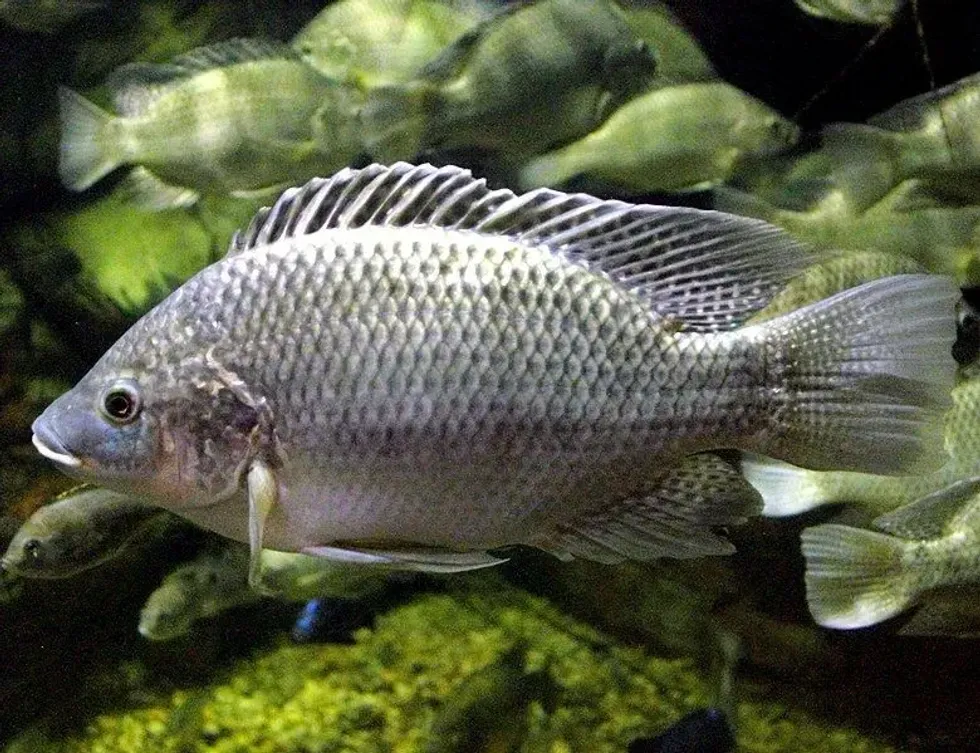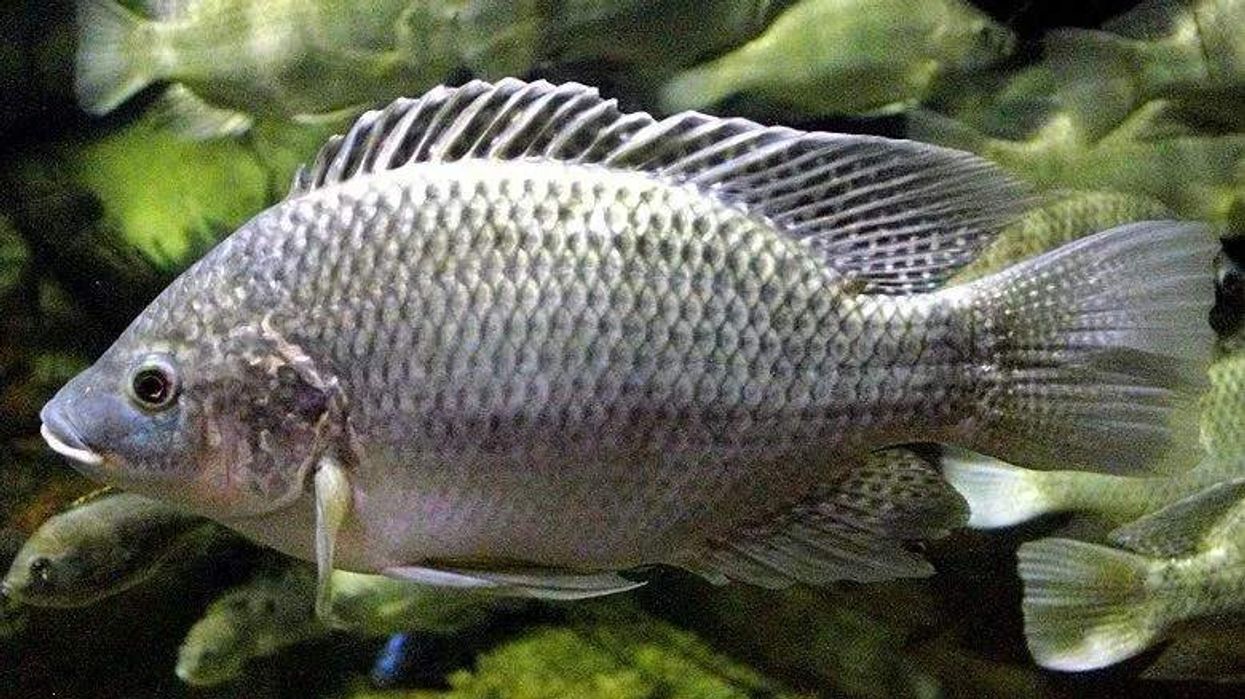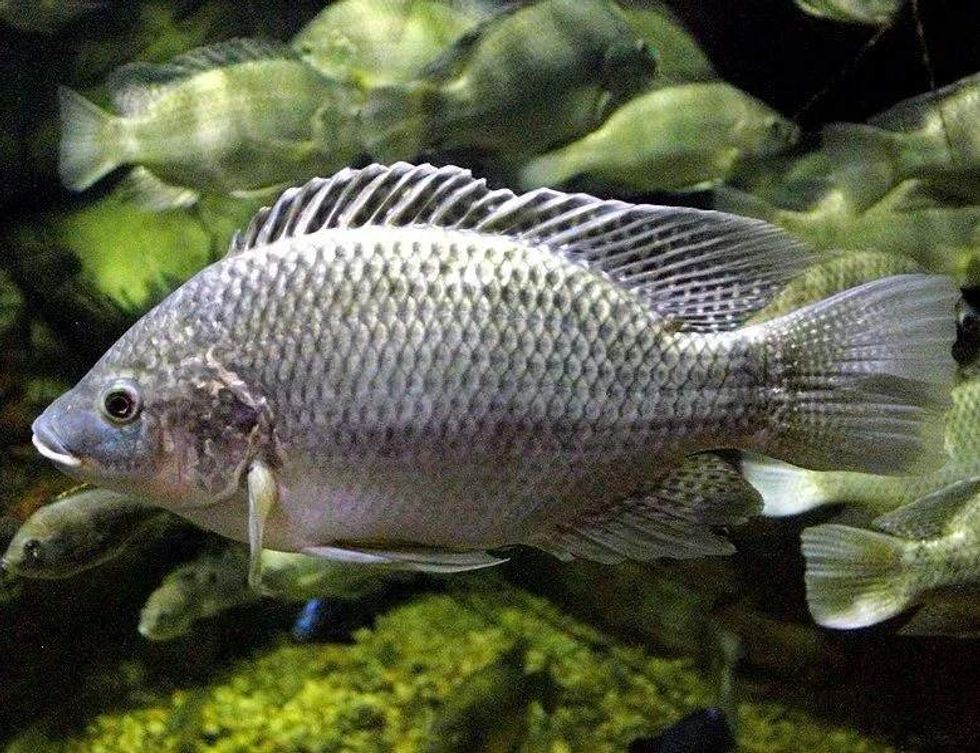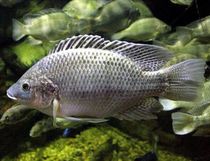Fun Mozambique Tilapia Facts For Kids
Have you ever had a look at a tilapia and wondered about its origin story? If not, then today, you are here to learn about the Mozambique tilapia (Oreochromis mossambicus).
This species is a native fish to the southern African region, but it has been introduced to different parts of the world. It can be found in a wide variety of aquatic habitats that may include freshwater bodies like a river or a pond and can even survive in brackish waters.
Its preferable range of temperatures is between 63–95 °F (17-35 °C). You may know about this fish because it is often associated with fisheries and aquaculture.
This fish has a compressed body, long and spiny dorsal fins, and is dull yellowish or greenish in color. An interesting thing about this fish is related to its breeding.
The fish species, Oreochromis mossambicus, performs mouthbrooding, where the eggs are carried inside the mouth of an adult. Even though this fascinating fish is present as an invasive species in many freshwater regions, this distribution hasn't stopped it from getting the Vulnerable status in its native place.
Want to learn more about this unique species? Do keep reading to get more Mozambique tilapia facts. Also, check out the articles on anglerfish facts and chinook salmon facts.
Mozambique Tilapia Interesting Facts
What type of animal is a Mozambique tilapia?
The Mozambique tilapia is a fish belonging to the family Cichlidae and is a popular tilapia species native to southern Africa. It shares the Cichlidae family with the spectacular rainbow cichlid.
What class of animal does a Mozambique tilapia belong to?
The Mozambique tilapia belongs to the class Actinopterygii and to the genus Oreochromis.
How many Mozambique tilapias are there in the world?
Even though the Mozambique tilapia is classified as a vulnerable fish species, it has grown as an invasive species in many parts of the world. Hence, it is really hard to note the exact population of these fishes.
Where does a Mozambique tilapia live?
The Mozambique tilapia is native or endemic to Southeastern Africa and South Africa. Apart from being present at the Zambezi basin in Mozambique, the fish is also seen in Malawi, Zambia, Zimbabwe, and in Bushman River of Eastern Cape, South Africa.
It has to share its home with the Nile tilapia, which was introduced into the area, and hybridization of the fishes also takes place.
You can also find the Mozambique tilapia as an introduced species or an invasive species, especially in tropical and subtropical countries. A significant population is seen in Florida and California, where it may compete with other species.
What is a Mozambique tilapia's habitat?
The habitat range of the Mozambique tilapia has a wide variety as it can adapt to different environmental conditions. These fishes can live in freshwater conditions as well as in brackish aquatic surroundings.
This is also why many people took this fish from its native distribution and introduced it to other parts of the world. These fishes aren't keen on living in fast-flowing habitats and prefer areas like rivers, streams, ponds, lakes, canals, swamps, and estuaries.
You will also find this fish as a part of aquaculture. It likes water temperatures between 63–95°F (17-35°C).
Who do Mozambique tilapias live with?
The Mozambique tilapia is known to live in groups. Apart from being introduced into different places, the Oreochromis mossambicus Mozambique tilapia managed to become an invasive species by rapid multiplication.
Tilapias follow a dominance hierarchy, and this distribution helps a fish to engage in different social interactions that include courtship and mating. The hierarchical distribution may even dominate the nest size that males might have.
The distribution of territories of males depends on their prowess and ability to navigate social positions. This also makes the males quite aggressive, and the adult fishes may end up fighting quite badly.
Females also prefer breeding with males that are present in higher social positions. Subordinate males often prefer to remain submissive and away from the dominant ones to reserve their energy and to avoid fights.
How long does a Mozambique tilapia live?
The average age range of the Mozambique tilapia is around 11 years.
How do they reproduce?
A dull and boring-looking fish may sometimes have a hidden feature that might blow your mind. When it comes to the Oreochromis mossambicus Mozambique tilapia, the fish may appear quite simple, but it holds an important secret to fish biology.
This fish breeds prolifically throughout the year, especially when the temperature is around 68°F. The males gather in an area to show dominance over each other to win the females.
These fishes do not breed in a fast river and rather prefer more calm water bodies. The unique thing about this fish is its parental care which includes keeping the eggs inside its mouth.
It is a great way to conserve energy. This phenomenon is also found in another cichlid species, the Nile tilapia.
Males are the ones to make nests where spawning takes place, and females can produce around 2000-4000 eggs after breeding. Once the breeding is over, the female proceeds to spawning and takes both the eggs and the sperm in its mouth.
With the help of this phenomenon, the females can easily transport the baby without any harm to it. Scientists think that this might also be the reason for its huge growth as an invasive species.
A female fish may often take care of the young fish until it reaches maturity to bond socially. The tilapia Mozambique can achieve sexual maturity at just three months of age.
What is their conservation status?
The Mozambique tilapia ( Oreochromis mossambicus) is currently classified under the status of being a Vulnerable species according to the International Union for Conservation of Nature Red List.
Mozambique Tilapia Fun Facts
What do Mozambique tilapia look like?

The Mozambique tilapia doesn't really have a special look, and its attributes are quite similar to the other fish present in the Cichlidae family. It has a medium-sized length with a fairly compressed body.
Tilapia fishes are known for having a long dorsal fin. Spines are present on the dorsal fin, and there is a spot near the fin that is more prominent in the case of juvenile fishes.
On the other hand, the caudal fin is more rounded. The fish has a greenish or yellowish color that looks quite dull. This species may also have a slight blue sheen on its body.
The adult males of this species have a snout with a duckbill-like look because of their enlarged jaws and mouth. This species is smaller in length compared to the Nile tilapia.
How cute are they?
The compressed body of a tilapia is quite lackluster, and the fish doesn't really have a great look. However, we do not really believe in calling a fish ugly; hence you can decide the cuteness level for this aquatic species yourselves!
How do they communicate?
Communication is quite interesting and important in fishes like Oreochromis mossambicus Mozambique tilapia as it lives with a lot of family members. In freshwater environments, urine acts as an essential guide and communication tool.
It is a way for the fish of the opposite sex to understand the biology of another fish. During the spawning season, the male Mozambique tilapia uses urine as a way to woo the females. Moreover, the female fish have the power to identify the social rank of the male.
Urine also helps the male fish to tower over other males and to show aggression. The males may even fight and harm each other to prove their might.
How big is a Mozambique tilapia?
The average body length of the Mozambique tilapia is around 15 in (39 cm). However, the length can definitely vary according to environmental circumstances. Compared to this fish, the average size of the peacock cichlid is around 4-6 in (10-15 cm), making it much smaller.
How fast can a Mozambique tilapia swim?
Not much is known about the swimming speed of this fish.
How much does a Mozambique tilapia weigh?
The average weight range of the adult Mozambique tilapia species is around 2.4 lb (1.1 kg). However, this may vary according to the place where the fish is kept along with its natural habitat.
What are the male and female names of the species?
There are no separate names for the male and females of the tilapia.
What would you call a baby Mozambique tilapia?
A baby of Mozambique tilapia species is known as fry.
What do they eat?
Mozambique tilapia is an omnivorous species that feed on small invertebrates, fry of other fishes, along with munching on detritus, diatoms, and macroalgae. These fishes are known for over-colonizing an are which leads to overcrowding of the natural habitat.
This can also lead to cannibalization, where the adult fish will end up eating the small ones. Feeding these fishes isn't hard when raised in aquaculture and fisheries.
Sometimes, these fishes are also introduced to freshwater bodies such as a river or a pond to attack mosquito larvae. People who want to keep this tilapia in an aquarium or a tank may want to feed it more commercial fish food.
Are they dangerous?
No, tilapias aren't inherently dangerous according to biology. However, in recent years more and more studies have found tilapia fishes to be unfit for consumption, especially due to the presence of high levels of mercury. Hence, if you aren't completely sure about its aquaculture, it's better to avoid having it as a source of consumption.
Would they make a good pet?
Well, if you happen to find a live Mozambique tilapia from somewhere, you may surely try to raise it as a pet. However, it isn't a great idea to get one from its natural river habitat or any other habitat.
We can't say which tilapia is the best; however, people do happen to have a fascination with the Nile tilapia and blue tilapia while thinking about creating a region for tilapias.
Did you know...
The Mozambique tilapia (Oreochromis mossambicus) was formerly classified as Sarotherodon mossambicus.
The dorsal fins of this species can get redder during the breeding season.
As the tilapia Mossambica can live in brackish water, it doesn't grow very fast and is quite smaller than other tilapia variants.
You might be perplexed to know that the tilapia Mossambica is actually banned in Australia. This species was introduced during the 1970s in Australia, and it quickly turned to be an invasive species.
It was originally intended to behave as an ornamental fish rather than a food source. However, its exponential growth turned harmful to the native biodiversity of Australia, and so they had to ban the fish. If you introduce this tilapia into the waters of Australia, you could very well end up in jail.
What was tilapia originally called?
Tilapia was originally called the Saint Peter's fish for its link to the Bible. The Nile tilapia is still popularly cultivated in the fisheries of Africa to feed people. In Hebrew, the tilapia fish is called 'amnoon', which stands for mother fish.
What are the four fish you should never eat?
The four fishes that you should avoid eating are tilapia, Atlantic cod, flounder, and bluefin tuna. There are various reasons for not consuming these fishes. Populations of the Mozambique tilapia and the bluefin tuna are decreasing drastically; hence it is better to live the fishes alone in their native habitat.
Here at Kidadl, we have carefully created lots of interesting family-friendly animal facts for everyone to discover! Learn more about some other fish including exquisite wrasse facts or royal gramma facts.
You can even occupy yourself at home by coloring in one of our free printable Mozambique tilapia coloring pages.
We Want Your Photos!
More for You
See All
Bachelor of Arts specializing in Journalism and Mass Communication, Postgraduate Diploma in Sports Management

Moumita DuttaBachelor of Arts specializing in Journalism and Mass Communication, Postgraduate Diploma in Sports Management
A content writer and editor with a passion for sports, Moumita has honed her skills in producing compelling match reports and stories about sporting heroes. She holds a degree in Journalism and Mass Communication from the Indian Institute of Social Welfare and Business Management, Calcutta University, alongside a postgraduate diploma in Sports Management.
Bachelor of Arts specializing in English Literature and Philosophy

Jacob FitzbrightBachelor of Arts specializing in English Literature and Philosophy
A highly motivated individual with a passion for writing and a talent for engaging with people. Jacob has a degree in English literature and philosophy from Oxford Brookes University, he has a strong academic background in critical thinking and analysis. He has honed his communication skills through his experience in hospitality, where he ran a successful bar and restaurant and developed his writing skills by creating weekly quizzes. In his free time, Jacob enjoys skateboarding, playing soccer, and solving puzzles.
Disclaimer
1) Kidadl is independent and to make our service free to you the reader we are supported by advertising. We hope you love our recommendations for products and services! What we suggest is selected independently by the Kidadl team. If you purchase using the Buy Now button we may earn a small commission. This does not influence our choices. Prices are correct and items are available at the time the article was published but we cannot guarantee that on the time of reading. Please note that Kidadl is a participant in the Amazon Services LLC Associates Program, an affiliate advertising program designed to provide a means for sites to earn advertising fees by advertising and linking to Amazon. We also link to other websites, but are not responsible for their content.
2) At Kidadl, we strive to recommend the very best activities and events. We will always aim to give you accurate information at the date of publication - however, information does change, so it’s important you do your own research, double-check and make the decision that is right for your family. We recognise that not all activities and ideas are appropriate for all children and families or in all circumstances. Our recommended activities are based on age but these are a guide. We recommend that these ideas are used as inspiration, that ideas are undertaken with appropriate adult supervision, and that each adult uses their own discretion and knowledge of their children to consider the safety and suitability. Kidadl cannot accept liability for the execution of these ideas, and parental supervision is advised at all times, as safety is paramount. Anyone using the information provided by Kidadl does so at their own risk and we can not accept liability if things go wrong.
3) Because we are an educational resource, we have quotes and facts about a range of historical and modern figures. We do not endorse the actions of or rhetoric of all the people included in these collections, but we think they are important for growing minds to learn about under the guidance of parents or guardians.







